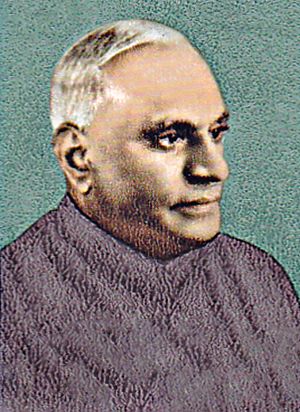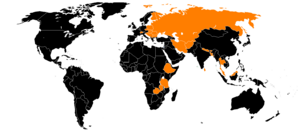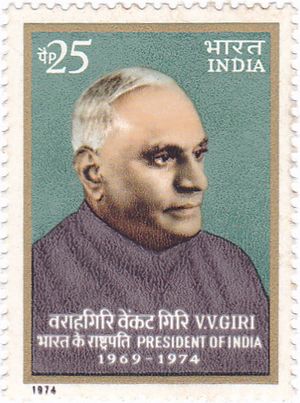V. V. Giri facts for kids
Quick facts for kids
Varahagiri Venkata Giri
వరాహగిరి వెంకట గిరి |
|
|---|---|

Giri portrait on a 1974 stamp of India
|
|
| 4th President of India | |
| In office 24 August 1969 – 24 August 1974 |
|
| Prime Minister | Indira Gandhi |
| Vice President | Gopal Swarup Pathak |
| Preceded by | Himself |
| Succeeded by | Fakhruddin Ali Ahmed |
| In office 3 May 1969 – 20 July 1969 (acting) |
|
| Prime Minister | Indira Gandhi |
| Preceded by | Zakir Hussain |
| Succeeded by | Himself |
| 3rd Vice President of India | |
| In office 13 May 1967 – 3 May 1969 |
|
| President | Zakir Hussain |
| Prime Minister | Indira Gandhi |
| Preceded by | Zakir Hussain |
| Succeeded by | Gopal Swarup Pathak |
| Governor of Mysore State | |
| In office 2 April 1965 – 13 May 1967 |
|
| Prime Minister | Indira Gandhi |
| Chief Minister | S. Nijalingappa |
| Preceded by | Satyawant Mallannah Shrinagesh |
| Succeeded by | Gopal Swarup Pathak |
| Governor of Kerala | |
| In office 1 July 1960 – 2 April 1965 |
|
| Chief Minister |
|
| Preceded by | Burgula Ramakrishna Rao |
| Succeeded by | Ajit Prasad Jain |
| Governor of Uttar Pradesh | |
| In office 10 June 1957 – 30 June 1960 |
|
| Chief Minister | Sampurnanand |
| Preceded by | Kanaiyalal Maneklal Munshi |
| Succeeded by | Burgula Ramakrishna Rao |
| Minister of Labour and Industry for Madras Presidency | |
| In office 30 April 1946 – 23 March 1947 |
|
| Chief Minister | Tanguturi Prakasam |
| Personal details | |
| Born |
Varahagiri Venkata Giri
10 August 1894 Berhampur, Madras Presidency, British India (present-day Brahmapur, Odisha, India) |
| Died | 24 June 1980 (aged 85) Madras, Tamil Nadu, India (present-day Chennai) |
| Cause of death | Heart attack |
| Political party | Independent |
| Spouse |
Saraswati Bai
(m. 1926; died 1978) |
| Relatives |
|
| Alma mater |
|
| Profession | |
| Awards | Bharat Ratna (1975) |
| Signature |  |
Varahagiri Venkata Giri (born August 10, 1894 – died June 24, 1980) was an important Indian leader. He served as the fourth President of India from 1969 to 1974. Before that, he was the third Vice President of India from 1967 to 1969. He was the first president to be elected without belonging to a major political party. In 1975, he received India's highest civilian award, the Bharat Ratna.
Contents
Early Life and Education
V. V. Giri was born in Berhampur, which was then part of the Madras Presidency (now Odisha). His family spoke Telugu and had moved to Berhampur from Andhra Pradesh. His father, V. V. Jogayya Pantulu, was a lawyer and a political activist with the Indian National Congress. Giri's mother, Subhadramma, was also active in India's freedom movement. She was even arrested for leading protests during the Civil Disobedience Movement.
Giri married Saraswati Bai, and they had 14 children.
He went to school in Berhampur and then studied at Khallikote College in Chennai. While in college, he was very active in the freedom movement. In 1913, he traveled to Ireland to study law at University College Dublin. He also met Mahatma Gandhi in London during this time.
While studying in Ireland, Giri was involved in both Indian and Irish politics. He wrote articles about the treatment of Indians in South Africa. He was also thought to be connected to leaders of the 1916 Easter Rising in Ireland. He finished his law studies in 1916 and was asked to leave Ireland soon after.
A Career in India's Freedom Movement
When Giri returned to India in 1916, he became a lawyer at the Madras High Court. He also joined the Congress party and supported the Home Rule Movement. In 1920, he gave up his law career to join Mahatma Gandhi's Non-cooperation movement. He was arrested for the first time in 1922 for protesting against liquor sales.
Role in the Labour Movement
Giri was deeply involved with workers' rights and trade unions in India. He helped start the All India Railwaymen's Federation in 1923 and was its general secretary for over ten years. He was also elected president of the All India Trade Union Congress (AITUC) in 1926.
In 1928, he led a peaceful strike by railway workers, which successfully won their demands. This was a big moment for the labour movement in India. He also helped form the Indian Trade Union Federation (ITUF) in 1929. Later, the ITUF merged back with the AITUC, and Giri became its president again in 1942.
Giri represented Indian workers at international conferences, like the International Labour Conference in 1927. He worked hard to get trade unions to support India's fight for freedom.
Political Career in British India
Giri became a member of the Imperial Legislative Assembly in 1934, where he spoke up for workers' rights.
In 1936, he was elected to the Madras Legislative Assembly. From 1937 to 1939, he served as the Minister for Labour and Industry in the government led by C. Rajagopalachari. When the Congress ministries resigned in protest against British rule in 1939, Giri returned to the labour movement. He was arrested and spent 15 months in prison.
He was imprisoned again in 1942 during the Quit India Movement. He stayed in prison for three years, his longest sentence, until 1945. After his release, he was re-elected to the Madras Legislative Assembly in 1946 and again became the Minister for Labour.
Career in Independent India
After India gained independence, Giri served as India's first High Commissioner to Sri Lanka from 1947 to 1951. In 1951, he was elected to the first Lok Sabha (India's lower house of Parliament).
Union Minister for Labour (1952–1954)
In 1952, Giri became the Minister of Labour. He believed that disagreements between employers and workers should be solved through talks and negotiations. This idea was known as the Giri Approach. However, he resigned in 1954 due to disagreements with the government over labour policies.
Serving as Governor (1957–1967)
Between 1957 and 1967, Giri served as the governor of three different Indian states:
- Uttar Pradesh (1957–1960)
- Kerala (1960–1965)
- Karnataka (1965–1967)
As Governor of Kerala, he helped the state get more funds for development. He also recommended President's rule twice when no single party could form a stable government.
Vice President and Acting President (1967–1969)
On May 13, 1967, Giri was elected the third Vice President of India. He held this position for about two years. When President Zakir Hussain passed away in May 1969, Giri became the acting president.
Giri resigned as acting president on July 20, 1969, to run for president as an independent candidate. Before resigning, he signed an order that nationalized 14 banks and insurance companies.
Presidential Election of 1969
The 1969 presidential election was a very close contest. Prime Minister Indira Gandhi supported Giri, even though her own party had officially chosen another candidate, Neelam Sanjiva Reddy. Gandhi asked members of her party to vote according to their "conscience," which meant they could vote for Giri.
The election was held on August 16, 1969. V. V. Giri won by a small margin, becoming president. After his election, some people challenged the results in the Supreme Court of India. Giri, which was unusual for a sitting president, appeared in court as a witness. The court eventually confirmed his election.
President of India
V. V. Giri became the President of India on August 24, 1969. He served until August 24, 1974. He was the only person to have been both an acting president and then elected president. He was also the only president elected as an independent candidate.
As president, Giri generally supported Prime Minister Indira Gandhi's decisions. For example, he agreed to her suggestion for early elections in 1971. He also signed an order to stop the special payments and privileges given to the former rulers of India's princely states.
Giri made 14 state visits to 22 countries during his time as president. These visits helped strengthen India's relationships with other nations. Some people saw him as a president who worked very closely with the prime minister. When his term ended in 1974, Indira Gandhi chose a different candidate, Fakhruddin Ali Ahmed, to be the next president.
Bharat Ratna Award
In 1975, V. V. Giri was awarded the Bharat Ratna, India's highest civilian honor. This award recognized his important contributions to public life. He was one of six Indian presidents to receive this prestigious award.
Death and Legacy
V. V. Giri passed away from a heart attack at his home in Madras on June 24, 1980.
He was given a state funeral the next day, and the Indian government declared a week of mourning.
Commemoration
In 1974, a special postage stamp was released to honor V. V. Giri. The National Labour Institute was renamed the V. V. Giri National Labour Institute in 1995. In his hometown of Berhampur, a major road, a school, and a market are named after him. He also donated his large historic home in Brahmapur to be used as a girls' school.
Giri wrote two important books about labour issues in India: Industrial Relations and Labour Problems in Indian Industry. His memoirs, which tell the story of his life, were published in 1976 and are called My Life and Times.
Honors and Awards
- Commemorative Medal of the 2500th Anniversary of the founding of the Persian Empire (1971)
- King Jigme Singye Investiture Medal (Kingdom of Bhutan, 1974)
- Bharat Ratna (Republic of India, 1975)
See also
 In Spanish: Varahagiri Venkata Giri para niños
In Spanish: Varahagiri Venkata Giri para niños
- List of Indian writers



